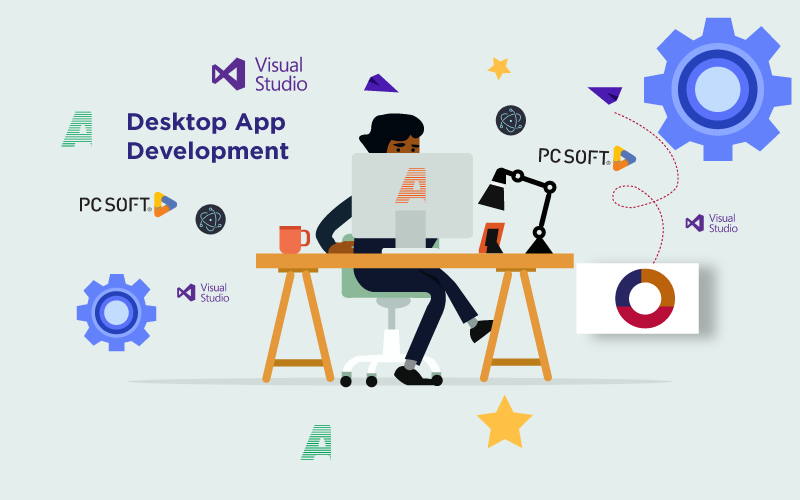
Desktop apps continue to play an important part in the ever-changing world of technology because they can cater to the individual demands of users, provide robust functionality, and ensure a flawless experience for users. Whether you’re a beginner coder or an experienced pro looking to start a new project, there is a clear set of steps you need to take to go from an idea to the successful launch of a desktop app. This complete guide will show you every step of making a desktop app, giving you useful information and useful tips to make sure the whole process goes smoothly.
Define Your App’s Purpose and Scope:
Before delving into the technical aspects of development, it’s crucial to define the purpose and scope of your desktop application. Clearly outline the problems it aims to solve, identify the target audience, and understand the unique selling points that will set your app apart from others in the market.
Conduct Market Research:

A thorough understanding of the market landscape is essential. Identify competitors, analyze user feedback on existing applications, and pinpoint the gaps in functionality or user experience that your app can address. This step helps in refining your app concept and positioning it effectively in the market.
Choose the Right Technology Stack:
Based on the requirements of your desktop application, select an appropriate technology stack. Consider factors such as the programming language, framework, and libraries that align with your project goals. Popular choices for desktop app development include Java for cross-platform applications, C# for Windows development, and Electron for building cross-platform apps using web technologies.
Create a Detailed Design and Wireframes:
Develop a comprehensive design that outlines the user interface (UI) and user experience (UX) of your application. Utilize wireframes and mockups to visualize the layout, features, and navigation flow. This step ensures that both developers and stakeholders have a clear understanding of the final product.
Begin the Development Process:
With a solid design in place, it’s time to start coding. Break down the development process into manageable sprints or milestones. Adhere to best coding practices, utilize version control systems, and collaborate effectively with your development team to ensure a streamlined workflow.
Implement Functionality and Features:

Gradually build the core functionality and features outlined in your design. Regularly test and debug the code to catch and address any issues early in the development process. Keep communication channels open within your team to foster collaboration and address any challenges promptly.
Perform Rigorous Testing:
Thorough testing is crucial to delivering a stable and reliable desktop application. Conduct unit testing, integration testing, and system testing to identify and rectify any bugs or performance issues. Utilize automated testing tools to streamline the testing process and ensure consistent results.
Optimize for Performance:
Focus on optimizing your desktop app for performance. Address any bottlenecks, reduce resource usage, and enhance overall responsiveness. A well-optimized application contributes to a positive user experience and sets the stage for successful user adoption.
User Acceptance Testing (UAT):
Before the official launch, conduct User Acceptance Testing to gather feedback from a select group of users. Use this feedback to make final adjustments, address any remaining issues, and ensure that the application meets user expectations.
Prepare for Deployment:
Once all tests are passed, and the application is polished, prepare for deployment. Choose an appropriate distribution method for your desktop app – whether through a dedicated website, app store, or other distribution channels.
Launch and Market Your App:
The big day has arrived—your desktop application is ready for launch. Create a marketing strategy to promote your app and reach your target audience. Utilize social media, online forums, and other channels to generate awareness and interest.
Gather and Analyze User Feedback:

Post-launch, actively collect user feedback. Understand how users are interacting with your application, identify areas for improvement, and release updates accordingly. Continuous improvement is key to maintaining user satisfaction and staying competitive in the market.
Scaling Up and Post-Launch Strategies:
Monitor Performance and Analytics:
After the launch, it’s crucial to monitor the performance of your desktop application. Utilize analytics tools to gather insights into user behavior, engagement metrics, and any performance issues. Regularly review this data to identify patterns, make informed decisions, and plan future updates.
Scale Infrastructure as Needed:
If your desktop app gains popularity and experiences increased user traffic, be prepared to scale your infrastructure. This may involve upgrading server capabilities, optimizing database performance, or utilizing content delivery networks (CDNs) to ensure a smooth and responsive experience for users.
Security and Updates:
Stay vigilant about security. Regularly update your application to patch vulnerabilities and address emerging threats. Implement secure coding practices, utilize encryption where necessary, and educate users on the best security practices to safeguard their data.
Release Feature Updates:
Keep your desktop app dynamic and competitive by releasing regular feature updates. Listen to user feedback, prioritize feature requests, and roll out updates that enhance functionality, address user pain points, and align with market trends.
Marketing and Outreach:

Maintain an active marketing strategy even post-launch. Regularly update promotional materials, engage with your audience through social media, and consider running targeted campaigns to reach new users or re-engage existing ones.
Evaluate and Plan for the Future:
Periodically assess the overall performance of your desktop app. Evaluate market trends, analyze competition, and be prepared to adapt your application to evolving user needs and technological advancements. Long-term success relies on staying ahead of the curve and anticipating the demands of your user base.
Conclusion:
Embarking on the journey from concept to launch in desktop app development requires meticulous planning, effective collaboration, and a commitment to delivering a high-quality product. By following these steps and staying adaptable to the evolving needs of your users, you can navigate the complexities of desktop app development and bring your vision to life. Remember, the success of your application lies not just in its launch but in the ongoing effort to enhance and refine the user experience over time.


